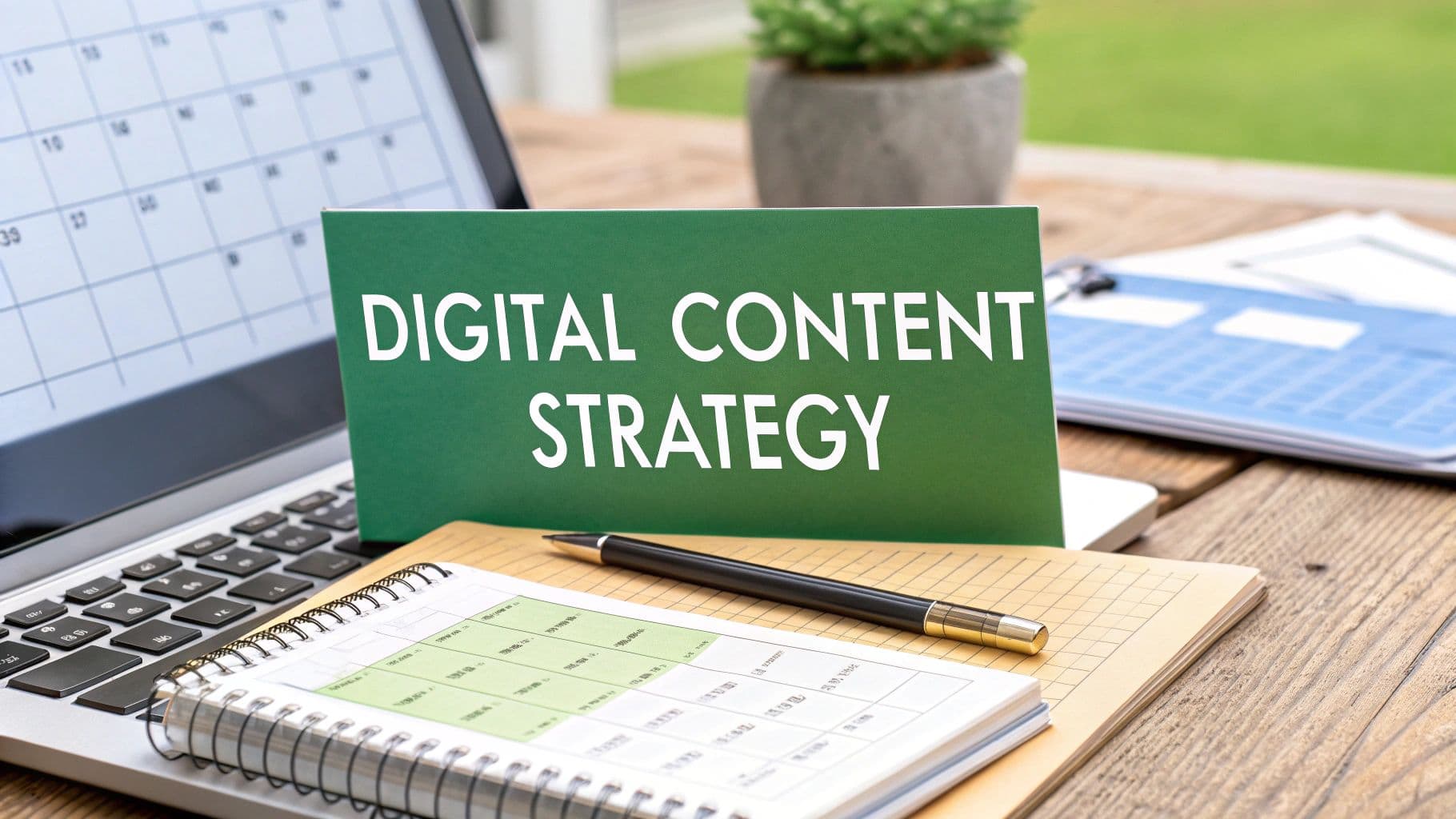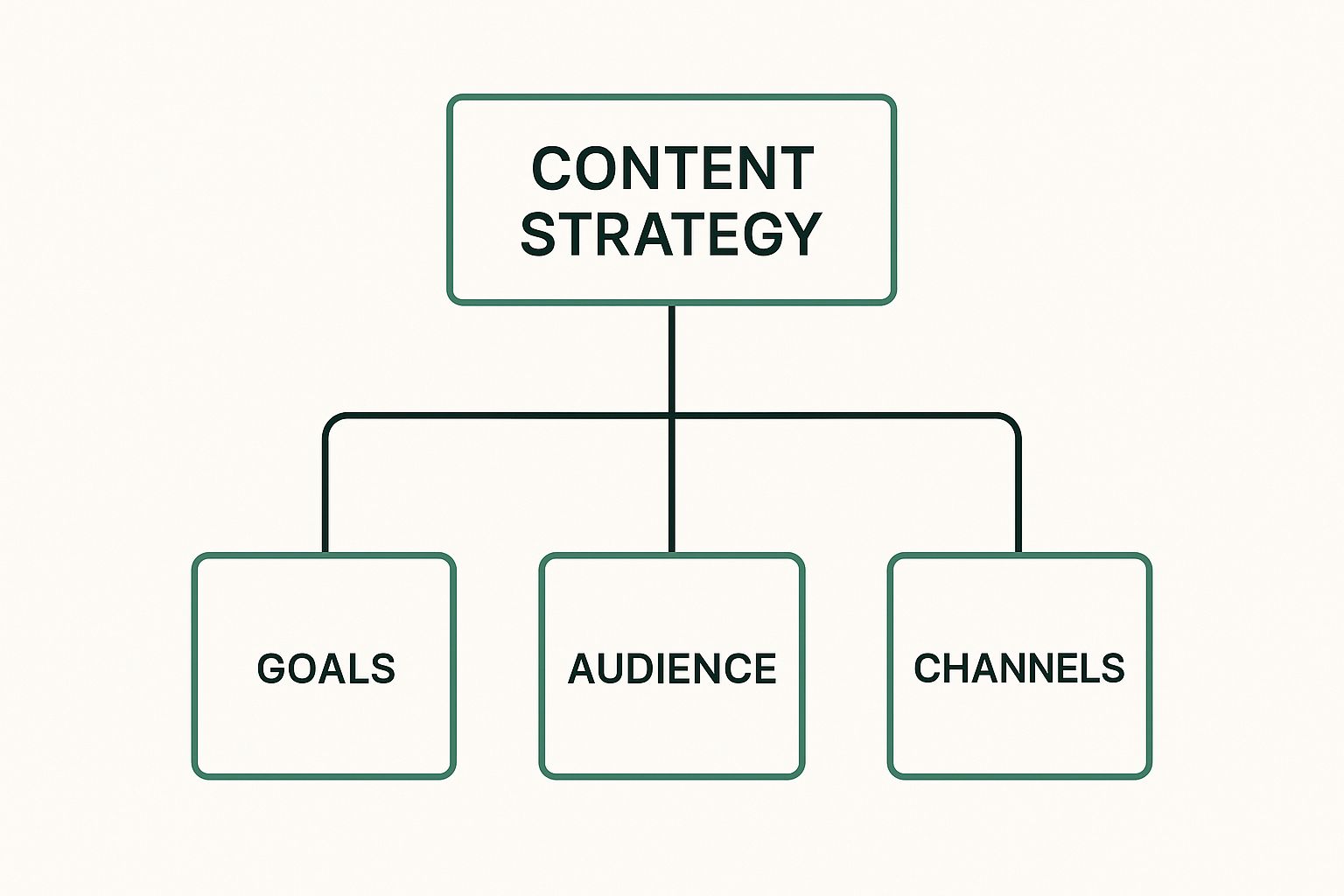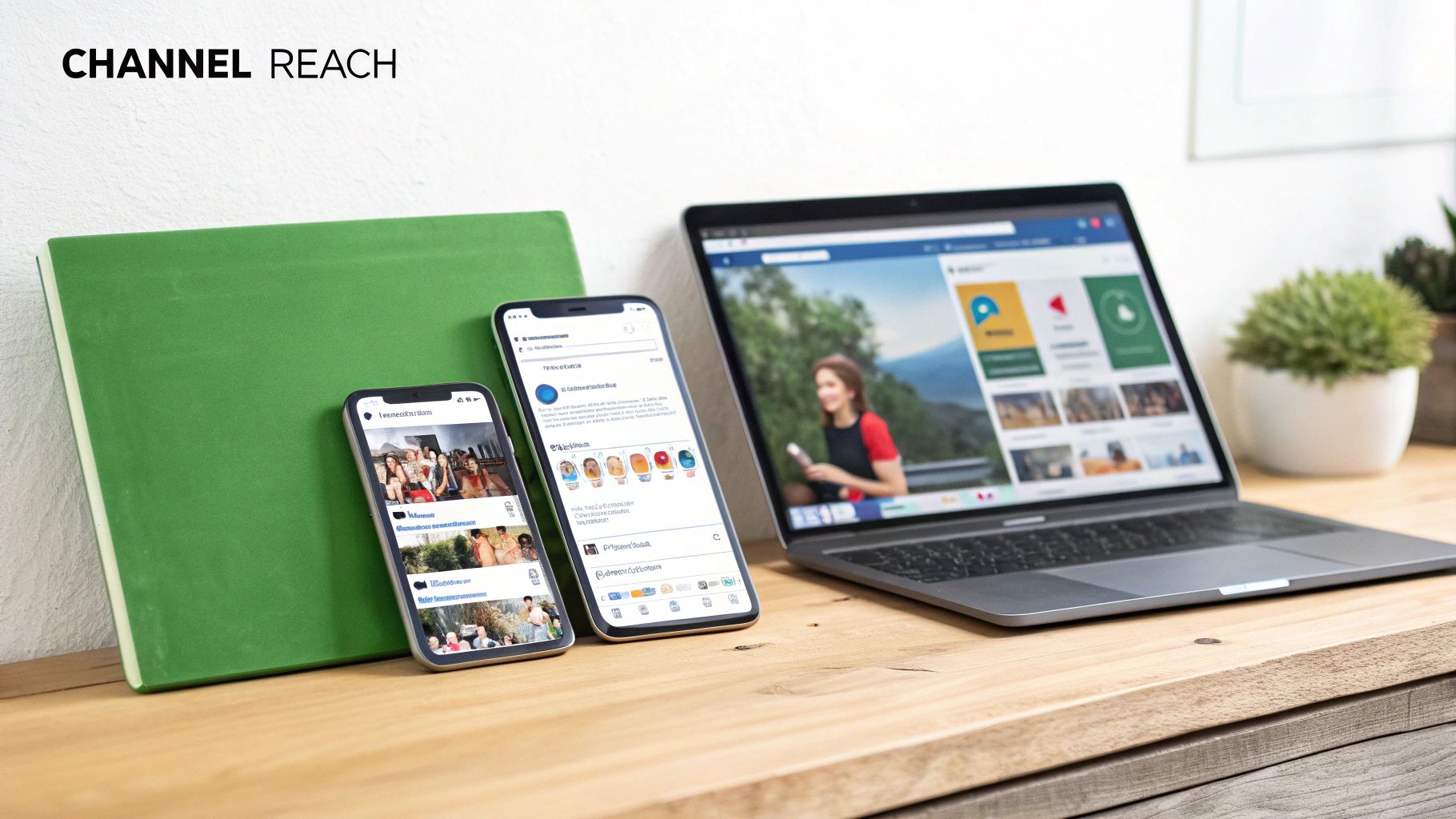
Mastering Digital Marketing Content Strategy
July 7, 2025
Let’s be honest. Tossing random blog posts and scattered social media updates into the ether isn't a strategy—it's just making noise. A real digital marketing content strategy is what separates the brands that thrive from those that just spin their wheels. It's the blueprint that turns your marketing from a guessing game into a predictable growth engine.
Why Your Content Strategy Is Your Greatest Asset
Imagine you’re a chef. Without a recipe, you’re just throwing ingredients in a pan, hoping for something edible. Sure, you might get lucky once in a while, but it’s messy, unpredictable, and you can’t do it again on purpose.
A content strategy is your master recipe. It’s the deliberate plan that dictates what you create, who you’re creating it for, and how it all connects back to your business goals. It ensures you cook up something valuable every single time.
This isn't just about scheduling posts. It's about building genuine authority and earning customer loyalty. When your content consistently solves problems and answers questions for your audience, you stop being just another company selling something. You become the go-to resource, the first name they think of when they need help in your niche.
The Foundation of Strategic Success
A solid strategy is the ultimate defense against wasted effort. It guarantees every blog post, video, and tweet has a clear purpose—whether that’s bringing in new people, nurturing leads, or delighting the customers you already have.
Without a plan, you're essentially working in the dark, creating content that could completely miss the mark. A well-defined strategy lights the way, drawing a straight line from the content you create to the results you can actually measure.
A great content strategy will attract and engage a target audience, meeting their needs while driving business goals. It is the foundation of the attract and delight stages in your marketing framework.
This simple infographic breaks down how a content strategy is built on the core pillars of your goals, audience, and channels.

As you can see, your business goals have to inform everything else—from who you target to where you reach them. Getting this hierarchy right is what makes a plan focused and effective.
To give you a clearer picture, let's break down these essential elements. The table below summarizes the core pillars that form the foundation of any successful content strategy.
Core Pillars of a Content Strategy
| Pillar | Core Function |
|---|---|
| Business Goals | Defines the "why" behind your content. It anchors every piece to a measurable business outcome, like leads or sales. |
| Target Audience | Identifies the "who" you are creating content for. It ensures your message is relevant, valuable, and speaks their language. |
| Distribution Channels | Determines the "where" your content will live. It focuses your efforts on the platforms your audience actually uses. |
| Content Types | Decides the "what" you will create. It matches the right format (blog, video, podcast) to the audience and channel. |
| Brand Voice | Establishes the "how" your content sounds and feels. It ensures consistency and builds a recognizable personality. |
| Metrics & KPIs | Measures the results. It tells you what's working and what's not, allowing for continuous improvement. |
Each pillar builds on the next, creating a complete framework that guides your decisions from big-picture objectives down to the finest details of execution.
Navigating a Crowded Digital Space
The need for a sharp content strategy has never been more urgent. With global digital ad spending projected to hit $740.3 billion by 2025, the competition for attention is fierce.
The days of just writing simple blog posts are long gone. Today, audiences are spread across podcasts, short-form video, and countless other formats. To meet them where they are, your approach has to be much more sophisticated.
To stand out, your content needs a clear, consistent personality. This comes from establishing a recognizable voice that connects with your audience no matter where they find you. If you're not sure where to start, you can learn more by reading our guide on developing strong brand voice guidelines. This is what makes every piece of content feel authentically you.
Alright, let's strip away the robotic feel and rewrite this section. Here’s a version that sounds like it’s coming from an experienced content marketer who’s been in the trenches.
Who Are You Talking To? And Why?
Before you even think about writing a blog post or designing an infographic, you have to nail down two things: who you're talking to and what you're trying to achieve. Get this wrong, and you’re just creating content for the sake of it—adding to the noise instead of building something valuable.
Think of it like this: you wouldn't build a house without a blueprint and a clear idea of who's going to live there. Your content is the house, your audience is the family moving in, and your goals are the reason you're building it in the first place.
Uncovering Your True Audience
Let's be honest, those generic customer personas aren't cutting it anymore. "Marketing Mary, age 35" is a nice start, but it doesn't tell you what keeps her up at night or what problems she's desperately trying to solve at work. To create content that actually connects, you need to go deeper.
It's time to put on your detective hat.
- Social Listening: Hang out where your audience does. Scroll through LinkedIn, X (formerly Twitter), or industry-specific Reddit threads. What questions pop up over and over? What are people complaining about? This is where you'll find raw, unfiltered insights into their biggest frustrations.
- Customer Interviews: Just talk to your best customers. Seriously. Ask them why they chose you, what specific problem you solved for them, and what a typical day looks like. These conversations are a goldmine for understanding their world.
- Survey Your Email List: Don't guess what your subscribers want. Ask them directly with a simple survey. "What's your biggest challenge right now?" or "What topics do you want to learn more about?" This gives you a cheat sheet for content they'll actually open and read.
This kind of research takes you from a fuzzy idea of "our customer" to a crystal-clear picture of the person on the other side of the screen. You'll know their exact pain points, which means you can create content that feels like it was written just for them.
Setting Goals That Actually Mean Something
Once you know who you’re talking to, you need to figure out what you want them to do. Fluffy goals like "increase traffic" or "get more engagement" sound nice in a meeting, but they're useless because they don't tie back to the business. This is where SMART goals come in.
A SMART goal is Specific, Measurable, Achievable, Relevant, and Time-bound. It turns a vague wish into a concrete target your team can actually work toward.
It’s the difference between saying "we should probably get more leads" and having a clear, actionable plan. One is a hope, the other is a strategy.
Here’s how to translate those common vague goals into powerful SMART objectives:
| Vague Goal | SMART Goal |
|---|---|
| Increase website traffic | Achieve 20,000 monthly unique visitors to the blog within six months by publishing two SEO-optimized articles per week. |
| Get more leads | Generate 150 marketing qualified leads (MQLs) from our new e-book in Q3 to support the sales pipeline. |
| Improve brand awareness | Increase our brand's share of voice on LinkedIn by 15% over the next quarter through consistent video and text posts. |
When you set these kinds of specific, measurable goals, every single piece of content has a job to do. You're no longer just publishing things into the void. You're strategically building assets designed to hit a clear business result. That alignment is the engine of a high-performing content strategy.
Choosing Your Channels and Mapping the Customer Journey

Okay, so you know who you’re talking to and what you want to achieve. The next logical step is figuring out where these conversations should happen. Your audience doesn’t live in just one place online, so your content can't either.
But here’s a common mistake I see all the time: spraying the same exact message across every single platform. This just leads to weak engagement and a lot of wasted effort.
A much smarter approach is to treat each channel like its own unique environment. Think of it like a real-life conversation. You wouldn't talk the same way at a formal business conference as you would catching up with a friend over coffee, right? Your digital marketing content needs that same social awareness.
The trick is to pick channels where your audience already spends their time and then create content that feels like it belongs there. Don't try to cram a dense, technical whitepaper onto a visual-first platform like Instagram. Instead, turn its key findings into a sharp, shareable infographic or a quick video.
Aligning Channels With Your Strategic Goals
Choosing the right platform isn't just about finding your audience; it's also about what you're trying to accomplish. Different channels are good at different things. Your job is to build a connected ecosystem where every platform has a clear role.
- For Building Authority (B2B): LinkedIn is king. It's the perfect spot for deep-dive articles, case studies, and professional discussions that cement you as an industry expert.
- For Visual Storytelling (B2C): Instagram and Pinterest are your go-to channels if you have a visually appealing brand. Use them for stunning product photos, behind-the-scenes stories, and user-generated content campaigns.
- For Community and Engagement: Facebook Groups and X (formerly Twitter) are fantastic for sparking conversations, getting real-time feedback, and sharing timely news.
- For In-Depth Education: Your company blog and YouTube channel are home base. This is where you house your big, foundational content—detailed tutorials, comprehensive guides, and deep dives that solve your audience's toughest problems.
The modern content world is absolutely dominated by social media. It's predicted there will be 5.42 billion social media users globally by 2025, with the average person hopping between nearly seven different social networks a month. This really hammers home the need for a multi-channel plan, but one where content is thoughtfully adapted for each. If you're stuck for ideas, we put together a great resource with social media content ideas to get you going.
Mapping Content to the Customer Journey
A truly great content strategy goes one step further. It doesn’t just think about the channel; it maps specific content to each stage of the customer's journey. This is how you deliver the right message at exactly the right time, gently guiding people from initial awareness all the way to a final decision.
Think of the journey in three main phases: Awareness, Consideration, and Decision. Each phase calls for a different type of content to meet the person where they are.
By aligning your content with the customer's mindset at each stage, you create an experience that feels seamless and genuinely helpful. You're not just selling; you're guiding them to the best solution.
Here’s what that looks like in practice:
| Customer Stage | Customer's Mindset | Content That Works Best |
|---|---|---|
| Awareness | "I have a problem, but I don't know what the solution is." | Educational blog posts, infographics, short videos, social media updates. The goal is to attract and inform, not to sell. |
| Consideration | "I'm exploring my options and comparing different solutions." | Detailed case studies, product comparison guides, webinars, in-depth ebooks. This is where you show why your solution is the best choice. |
| Decision | "I'm ready to buy, but I need to be sure this is the right choice." | Free trials, live demos, customer testimonials, pricing pages. This content builds that final layer of trust and makes buying easy. |
When you strategically choose your channels and map your content to this journey, you stop doing random acts of marketing and start building a deliberate, effective system. Every piece of content has a purpose, every platform has a role, and your audience gets value at every single touchpoint.
Alright, you’ve mapped your customer's journey and picked your channels. Now comes the fun part—actually creating the stuff people will read, watch, and engage with. This is where the blueprint becomes reality. A plan is one thing, but making content is what gets you from A to B.
Think of it like this: you wouldn't eat the same meal every single day, right? Your content strategy needs that same variety. A healthy mix of formats keeps your audience nourished and your business growing. Relying on just one content type is a recipe for boredom; you need a balanced diet to keep people coming back for more.
The Four Essential Content Types
To build a strong presence, you really want to lean on four key content "food groups." Each one has a specific job to do, and when they work together, they create a seriously powerful marketing engine.
- Blog Posts for Authority: Your blog is your home base. It's where you prove you know your stuff. With in-depth, SEO-friendly articles, you can answer your audience’s biggest questions, pull in organic traffic, and build trust that lasts.
- Video for Engagement: Let's be real, attention spans are short. Video is king when it comes to grabbing and holding interest. Whether it's a quick clip for social media or a detailed tutorial on YouTube, video makes complex ideas easy to grasp and helps you build a more personal connection.
- Social Media for Community: Think of your social media channels as your digital town square. This is your spot for sharing bite-sized tips, jumping into real-time chats, and building a loyal community around what you do. It’s less about the hard sell and more about building relationships.
- Lead Magnets for Conversion: This is content with a clear goal. We're talking e-books, checklists, templates, and webinars—things so valuable that people will gladly give you their email to get their hands on them. This is how you turn casual visitors into real, qualified leads.
How to Never Run Out of Ideas
One of the biggest hurdles is the blank content calendar staring back at you. It can be intimidating. But if you have a system for brainstorming, it’s not so scary. Start by defining your broad "topic pillars"—these are the handful of core subjects your brand wants to be known for.
From there, you just break each pillar down. For instance, a pillar like "Email Marketing" can splinter into subtopics like "Growing Your List," "Writing Killer Subject Lines," or "Setting Up Automations." Suddenly, you have a deep well of ideas to pull from.
A brand style guide is your content's DNA. It defines your tone of voice, your look, and your messaging rules. It’s what ensures every single piece of content feels like you, no matter who created it.
That consistency is everything. When someone sees your content on LinkedIn, your blog, or in an email, it should feel instantly familiar. If you're looking to really nail that part, our guide on how to write compelling content has some practical tips to make your words stick.
The Human-AI Partnership
These days, AI tools can seriously speed up content creation, from outlining ideas to polishing drafts. Using AI for the grunt work is just smart. But it should never, ever replace the human touch. AI is a fantastic assistant for organizing data and structuring an article, but it has zero real-world experience or empathy.
The best strategies find a balance. Let AI handle the heavy lifting and the repetitive tasks. That frees up your human creators to do what they do best: tell stories, share unique insights, and forge a genuine emotional connection with your audience. Your empathy is your secret weapon. It’s what turns a good piece of content into a great one.
Making Sure Your Content Gets Found and Seen

Here's the hard truth: creating incredible content is only half the job. If nobody ever finds it, all that effort is a wasted investment. This is where search engine optimization (SEO) stops being a technical buzzword and starts being your content’s best friend. It’s how you make sure your hard work gets the audience it deserves.
Think of your content as a brand-new shop and search engines as the busiest streets in town. SEO is what gets your shop a prime spot right on Main Street, where all your ideal customers are already walking by.
Without it, your amazing store is stuck on a forgotten side road, hoping someone stumbles upon it by sheer luck. A real digital marketing content strategy doesn’t just hope for visibility; it engineers it from day one.
Satisfying User Intent: The Real Goal of SEO
Modern SEO isn’t about tricking Google. It’s about understanding people. The single most important concept to grasp is user intent—the "why" behind every single search query. When someone types a phrase into a search bar, they're on a mission.
Are they trying to learn something? Find a specific website? Buy a product? Your content’s job is to satisfy that need completely and quickly. If you get this right, search engines will reward you with better rankings. It’s that simple.
Here are the main types of intent you need to think about:
- Informational Intent: The user wants an answer (e.g., "how to start a blog"). Your content needs to be the clearest, most helpful answer out there.
- Navigational Intent: The user is looking for a specific site (e.g., "Natural Write login"). Your own branded pages must be easy to find.
- Transactional Intent: The user is ready to buy something (e.g., "buy noise-cancelling headphones"). This is where your product and sales pages need to shine.
- Commercial Investigation: The user is close to buying but is still comparing options (e.g., "best project management software"). Reviews, comparisons, and in-depth guides are perfect here.
Matching your content to one of these intentions isn't just a good idea—it's essential for getting found.
Your On-Page SEO Checklist
On-page SEO refers to all the things you do directly on the page to make it clear what your content is about. It’s how you signal to both people and search engines that you have what they're looking for.
Think of on-page SEO as putting a clear, accurate label on a jar. The label tells you exactly what’s inside, so you don’t have to guess. Good on-page SEO does the same for your content.
Here’s a quick checklist to run through for every piece of content you publish:
- Compelling Title Tag: This is your headline in the search results. It must grab attention, include your main keyword, and earn the click.
- Strategic Keyword Placement: Weave your primary keyword into the first 100 words or so. Make sure it also appears in at least one subheading (H2 or H3) and a few more times naturally in the text.
- Reader-Friendly URL: Keep URLs short and descriptive. Always try to include the keyword (e.g.,
naturalwrite.com/blog/how-to-humanize-ai-text). - Engaging Meta Description: This is the little sales pitch under your title in the search results. It needs to be compelling and include your keyword to reinforce what the page is about.
- Internal Linking: Link out to other relevant articles and pages on your own website. This helps search engines map your site and keeps visitors clicking around longer.
Investing in SEO is more critical than ever. With the content marketing industry projected to hit $94 billion in revenue by 2025 and blogs being used by 76% of marketers, the competition is fierce. The top result on Google gets nearly 40% of all clicks, which proves that being visible is everything. You can discover more insights from these digital marketing statistics to see just how competitive the field is. This data makes one thing crystal clear: creating content without a plan for people to see it is a massive missed opportunity.
Measuring What Matters and Refining Your Approach

A brilliant content strategy is useless if you can’t tell whether it's actually working. Without tracking performance, you’re just creating content and hoping for the best. It’s like driving with your eyes closed—you’re moving, but you have no idea if it’s in the right direction.
It's time to get past the surface-level "vanity metrics" like likes and shares and focus on what truly moves the needle.
The secret is to measure your content against the specific business goals you set from day one. This creates a powerful feedback loop, turning raw data into actionable insights. It’s how you stop guessing what your audience wants and start knowing, allowing you to fine-tune your approach for better and better results.
Identifying Your Key Performance Indicators
Your Key Performance Indicators (KPIs) are the specific, measurable metrics that tell you if you're on track to hit your goals. Instead of drowning in a sea of data, you just need to pick a handful of KPIs that directly reflect your main objectives.
Think of it this way: if your car's goal is to get you to a destination, your speedometer and fuel gauge are your KPIs. They give you the critical information you need to make decisions. In content marketing, your KPIs do the same thing—they guide your strategic choices.
Here are some of the most important KPIs, broken down by what they help you measure:
- Traffic & Awareness: These metrics show how well you're attracting an audience. Look at organic sessions (visits from search engines), new vs. returning users, and the number of backlinks you’ve earned.
- Engagement: This tells you if your content is actually connecting with people. The key metrics here are average time on page, bounce rate, and pages per session.
- Conversion: This is where the rubber meets the road. Are you turning visitors into leads? Track things like lead magnet downloads, newsletter sign-ups, and contact form submissions.
The best content strategies are living documents, not one-time projects. They are constantly refined by performance data, ensuring every piece of content you create is more effective than the last.
This cycle of creating, measuring, and refining is what separates good strategies from great ones. It makes sure your efforts are always tied to real-world results.
Building Your Performance Dashboard
You don’t need a complicated or expensive system to track your progress. A simple performance dashboard, built with free tools like Google Analytics 4 (GA4) and Google Search Console, can give you everything you need. The goal is to see your most important KPIs in one place for quick, easy analysis.
When you organize your data this way, you can spot trends, identify your best-performing content, and pinpoint what needs work. For example, if you see an article with tons of traffic but a low time on page, you know the topic is resonating but the content itself isn't holding people's attention.
The table below breaks down which metrics to focus on based on your primary marketing goals. Use it as a starting point for building your own dashboard.
Key Content Marketing Metrics by Goal
This table helps you connect your overarching marketing goals to the specific data points that prove your content is doing its job.
| Marketing Goal | Primary Metric to Track | Supporting Metrics |
|---|---|---|
| Build Brand Awareness | Organic Traffic / Sessions | Social Media Reach, Keyword Rankings |
| Generate Leads | Conversion Rate (e.g., form fills) | Leads Generated, Cost Per Lead (CPL) |
| Improve Engagement | Average Time on Page | Bounce Rate, Comments/Shares |
| Drive Revenue | Content-Assisted Conversions | Return on Investment (ROI) |
By tracking the right metrics for your goals, you can see exactly what's working and what isn't, allowing you to make smarter, data-driven decisions.
Ultimately, measurement is what closes the loop on your digital marketing content strategy. It transforms your plan from a static document into a dynamic engine for growth. Using real data to prove the value of your content ensures your strategy never gets stale—it just keeps getting better.
Answering the Tough Questions About Content Strategy
Even with the best plan in hand, you’re going to have questions. It’s just part of the process. Getting a content strategy off the ground often means bumping into a few common uncertainties. So, let's clear them up right now.
A big one I hear all the time is, "How much content do we actually need to make?" People get hung up on this, but there's no magic number. It all comes back to your goals and what your team can realistically handle. The real key is consistency, not volume. Pushing out one truly helpful, well-researched article every week is a thousand times better than spamming your audience with three shallow posts that don't solve any real problems.
Then there's the budget question. "How much should we be spending on this?" It’s a fair question, and the answer is to stop thinking of content as a cost. It’s an investment.
A well-executed digital marketing content strategy is a business asset that appreciates over time. Unlike a paid ad that disappears when you stop paying, a top-ranking blog post can generate leads for years.
How Long Until I See Results?
This is the big one, isn't it? While you can get instant feedback from paid ads, content marketing is a slow burn. You're building a relationship with your audience and with search engines, and that doesn't happen overnight. It typically takes a good 6 to 12 months of consistent, quality work to see real, meaningful results in organic traffic and leads.
Patience is your best friend here. Earning trust takes time. Here’s a rough timeline of what to expect:
- Months 1-3: You're laying the groundwork. Focus on creating great content and watch for early signs of life, like how long people are sticking around on your pages or if they’re sharing your stuff on social media.
- Months 4-6: You should start to see some movement. Your articles might begin climbing the keyword rankings, and you’ll notice a slow, steady trickle of organic traffic starting to build.
- Months 7-12: This is where things get exciting. If you’ve stayed consistent, the momentum really starts to pick up. Expect to see significant growth in your traffic, leads, and a clear return on your investment.


